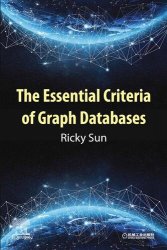The Essential Criteria of Graph Databases
- Добавил: literator
- Дата: 25-01-2024, 21:41
- Комментариев: 0
 Название: The Essential Criteria of Graph Databases
Название: The Essential Criteria of Graph DatabasesАвтор: Ricky Sun
Издательство: Elsevier/China Machine Press
Год: 2024
Страниц: 398
Язык: английский
Формат: pdf (true)
Размер: 35.5 MB
Although AI has incredible potential, it has three weak links: 1. Blackbox, lack of explainability, 2. Silos, slews of siloed systems across the AI ecosystem, 3. Low-performance, most of ML/DL based AI systems are SLOW. Fixing these problems will pave the road to strong and effective AI. Graph databases, particularly high-performance graph database or graph computing, should allow this to happen. The Essential Criteria of Graph Databases simply broadens the horizon of graph applications. The book collects several truly innovative graph applications in asset-liability and liquidity risk management, which hopefully will spark readers’ interest in further broaden the reach and applicable domains of graph systems.
Graph database technology is the only way and important tool for Artificial Intelligence (AI) to move toward Artificial General Intelligence (AGI). Because the graph database (including knowledge graph) restores (simulates) human thinking and way of thinking to the greatest extent.
- Presents updates on the essential criteria of graph database(s) and how they are quite different from traditional relational database or other types of NoSQL DBMS or any of those big-data frameworks (i.e., Hadoop, Spark, etc.)
- Clearly points out the key criteria that readers should pay attention to
- Teaches users how to avoid common mistakes and how to get hands-on with system architecture design, benchmarking or selection of an appropriate graph platform/vendor-system
Today, academia and a considerable number of knowledge graph companies are using RDF to describe the “metadata” in the graph. The default query language of RDF is SPARQL Protocol and RDF Query Language (SPARQL). But the problem with RDF and SPARQL is that the logic is complex, verbose, and hard to maintain—developers don’t like it. For example, do you prefer eXtensible Markup Language (XML) or jаvascript Object Notation (JSON)? Probably JSON, right? Because it is simpler and more convenient. After all, being lightweight and fast is the main theme of the Internet age.
The GQL (Graph Query Language) standard is due to be released by late 2023 or 2024, it is currently in DIS (Draft International Standard) mode, and it can trace its origin to PGs and LPG (Labeled Property Graphs), whereas LPG is considered a special form of PG, and popularized by Neo4j. As the name implies, PG is a graph with properties or attributes. For the two types of basic data types (meta-data) in the graph: Both nodes and edges can have attributes such as name, type, weight, timestamp, etc. Other than Neo4j, there are a handful of PG graph players such as TitanDB, JanusGraph (a derivative of Titan), Neptune of AWS, DGraph, TigerGraph, ArangoDB, Memgraph, Ultipa Graph, and so on.
The good news is that 40 years after SQL dominated the database world, the second set of international standards GQL will finally be ushered in. Interestingly, the development of NoSQL in the field of big data in the past 20 years has not spawned any international standards. On the contrary, the development of graph databases will usher in their international standards, which just shows the converging trend toward a standardized future of the graph database industry. If Human brains were to be the ultimate database, Graph Database is the shortest path to be there!
In this book, the author will invite the readers to have an overview of the past, present, and future development trends of the graph databases from the perspective of being close to the market and business needs, and close to the essence of technology implementation.
Скачать The Essential Criteria of Graph Databases
[related-news] [/related-news]
Внимание
Уважаемый посетитель, Вы зашли на сайт как незарегистрированный пользователь.
Мы рекомендуем Вам зарегистрироваться либо войти на сайт под своим именем.
Уважаемый посетитель, Вы зашли на сайт как незарегистрированный пользователь.
Мы рекомендуем Вам зарегистрироваться либо войти на сайт под своим именем.
